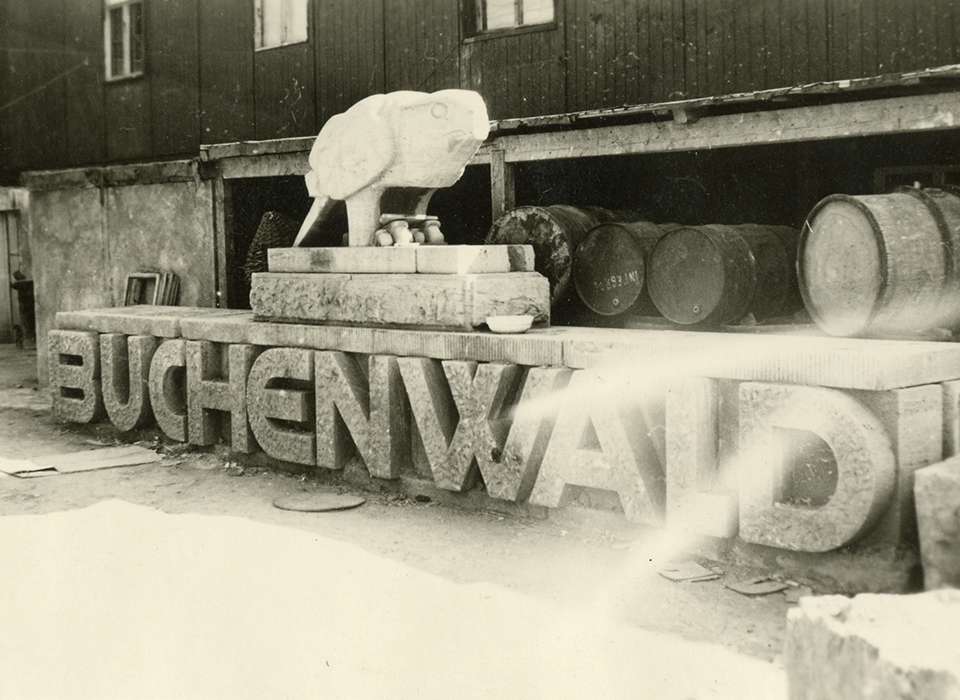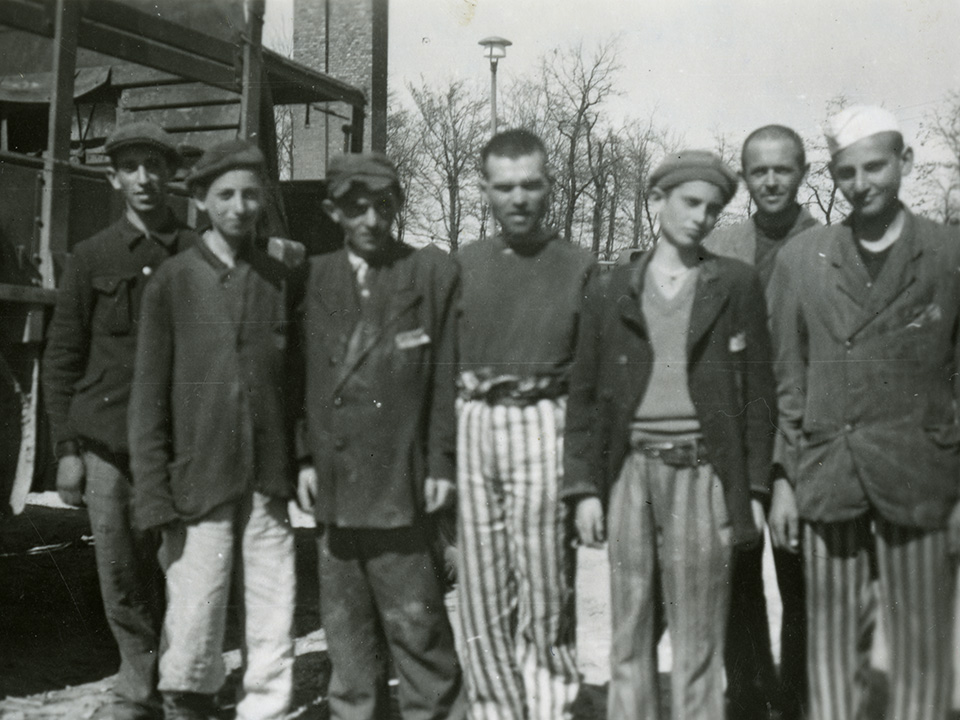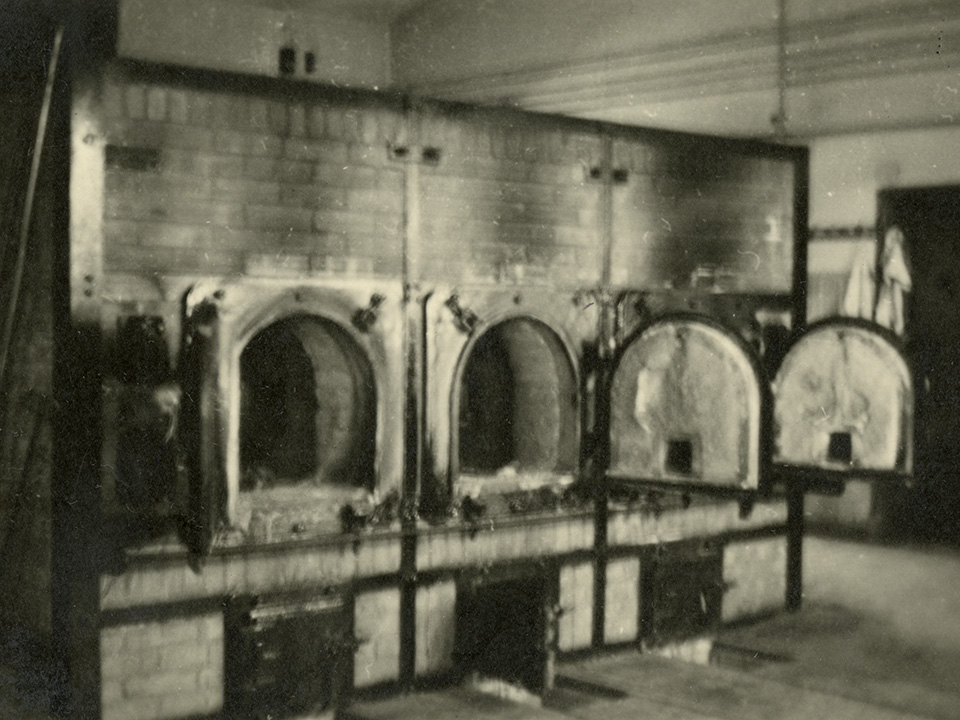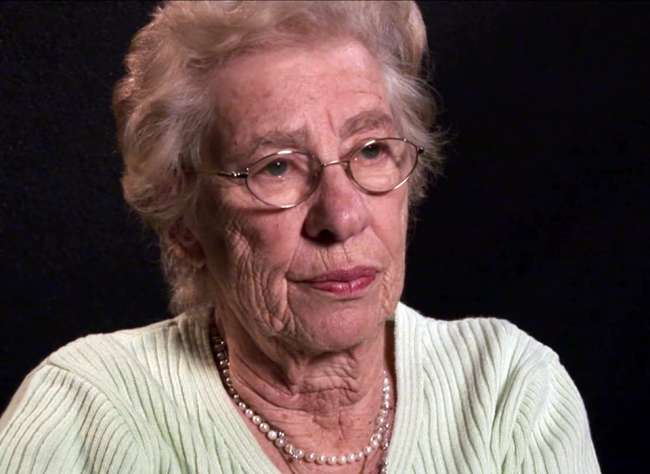Top Image: Stone carving spelling out “Buchenwald.” From the Collection of The National WWII Museum, Gift of Ronello Brown, 2008.002.002.
“You couldn’t grasp it all,” said Andrew Kiniry when asked about his time in the recently liberated Buchenwald concentration camp in the spring of 1945. These words, spoken during his oral history with The National WWII Museum, express a simple, direct truth. A member of the 45th Evacuation Hospital attached to General George S. Patton’s Third Army, Kiniry was not among the first to go into Buchenwald. Yet what he witnessed on the grounds of that place of horror, between April 28 and May 11, 1945, seared his memory and challenged his comprehension. “I can’t really describe it, to tell you how horrendous it was to see these people treated like animals. Even worse than that.”
Kiniry recalled all the bodies, human beings totally bereft of life, piled in trenches or on carts. And the dreadful stench. “I don’t think they told us what we were getting into,” he said. Once there, the 45th acted with urgency and dedication. Tuberculosis tests were arranged and soup provided to the emaciated former inmates suffering from shrunken stomachs. The necessity of maintaining good hygiene in the camp, however, was not easy; many of the freed individuals initially refused to take showers, remembering just how the SS used showering facilities. To aid their work, Kiniry and his unit supervised Germans brought in from nearby Weimar to clean the camp. Never did he believe their claims they knew nothing of Buchenwald. The smell of death emanating from the camp alone refuted such assertions.
On April 11, 17 days before Kiniry set foot there, the 6th Armored Division of Patton’s Third Army reached Buchenwald. Commanded by Major General Robert W. Grow, the “Super Sixth,” as it was nicknamed, had been in the field since mid-July 1944. The division had pushed into Thuringia, in east-central Germany, and seized Mühlhausen on April 4. For all their experience of combat in five campaigns, what the men of the 6th beheld in the Buchenwald Konzentrationslager (concentration camp) on the afternoon of the 11th truly horrified them. It was catastrophic, yet it was no real shock.
A week earlier, on April 4, troops from the 89th Infantry Division, 4th Armored Division, and the 602nd Tank Destroyer Battalion overran Ohrdruf, a recently established subcamp of Buchenwald. While most of the nearly 12,000 inmates of Ohrdruf had been moved, many to the main camp, the hundreds of corpses found in various stages of decomposition testified to the true essence of Nazism. The inspection of this appalling site on April 12 by Dwight D. Eisenhower, Omar Bradley, and Patton has become an integral part of what Americans learn about liberation. After the inspection, Eisenhower, it must always be remembered, declared, “We are told that the American soldier does not know what he is fighting for. Now, at least, he will know what he is fighting against.”
Evidence of what they were fighting against struck like an avalanche in the following days. Buchenwald was the first of the major concentration camps of Greater Germany to be liberated. Established in 1937 on the northern side of the Ettersberg, a hilly, forested area, it was only four miles northwest of the famed Thuringian city of Weimar, a locale associated with the great German writers Johann Wolfgang von Goethe and Friedrich Schiller. During my visit to Buchenwald in June 1998, I, like so many others, was amazed by the beauty of the surrounding region and the heritage of humanism linked to Weimar. And, yet, a short distance away stood a SS-run concentration camp where 56,000 men, women, and children were murdered or died from maltreatment, exposure, starvation, or illness.
Originally planned to primarily isolate political opponents from German society, the Nazis deported some 10,000 Jews to Buchenwald after Kristallnacht in November 1938. The SS soon incarcerated Roma and Jehovah’s Witnesses there. The camp also held convicts (hostility between the “politicals” and common criminals grew very quickly). Once war began, large numbers of Polish and Soviet POWs, resistance fighters from many parts of Europe, and forced laborers swelled the ranks of Buchenwald. As the Red Army drove deeper into Poland in the winter of 1944-45, inmates from Auschwitz-Birkenau were transported to the camp. Before the Americans closed in on the area, overcrowding, disease, and food shortages created a state of emergency among the prisoners.
A massive evacuation effort by the SS preceded the arrival of the Americans on April 11. Historian Dan Stone reports that camp personnel removed 23,000 inmates by train to Flossenbürg, Dachau, and Theresienstadt (other estimates put the number evacuated at 26,000-28,000). They left behind some 21,000 human beings. About 4,000 were Jews and 850 of them children. Within Buchenwald, an International Camp Committee led by communists, had prepared to greet US forces. Listening clandestinely to radio reports, inmates realized the Americans were close. They had done everything they could do to hinder the evacuation. When Commandant Hermann Pister and the last of the SS fled late in the morning of the 11th, the prisoners distributed weapons long hidden from the Germans (including rifles, machine guns, and hand grenades) and took control of the watchtowers. One of their own, Camp Elder Hans Eiden, assumed responsibilities as temporary head of the camp. A white flag was hoisted. Functionaries were ordered to continue their tasks and discipline demanded of everyone. In the adjacent woods, inmates now armed captured more than 70 SS men. The SS had absconded, though, with the remaining bread. Compounding the hunger, outbreaks of disease, especially typhus and dysentery, had been devastating.
With the camp secured, American personnel had the opportunity to observe and understand the manifold terrors the Nazis implemented. They discovered the block for medical experiments (vivisections on healthy individuals; use of phosphorus; “research” on typhus). From the inmates, they pinpointed the scattered sites for execution and photographed the six ovens in the camp’s crematorium, with human remains still present. The colossal tasks of documenting and communicating what had occurred in Buchenwald had only just begun for American investigators.
Legendary CBS journalist Edward R. Murrow was one of those who came to the camp immediately after liberation, arriving on Thursday, April 12. Three days later, he broadcast to audiences in the United States a description of what he encountered, a broadcast prefaced with strong warnings about the extreme content therein. Once he entered Buchenwald, the former inmates crowded around him and praised President Franklin Roosevelt. As Murrow related, hearing the appreciation for the president touched him so deeply, since, unbeknownst to the liberated, the president died that very day. The CBS reporter walked on into a barracks, once a stable, filled with men from Czechoslovakia. They wished to lift him onto their shoulders to show their gratitude to him and the other Americans but were too feeble to do so. Many remained bed-ridden. Before stepping out, he counted the names of 242 people who had died in the barracks in the previous month.
Out on the campgrounds, Murrow saw terribly weakened men crawling to the latrine and children displaying the numbers tattooed on their arms. In Buchenwald’s infirmary, he learned that more than 200 had succumbed to illness or starvation the previous day. The greatest shock he experienced was the confrontation with “two rows of bodies stacked like cordwood,” a phrase that would become, for better or worse, an expression almost ritually verbalized when discussing the Nazi camps. Murrow estimated there were 500 corpses piled there. Realizing that some might disbelieve such revelations, Murrow pleaded with his listeners: ”I pray you to believe what I have said about Buchenwald. I have reported what I saw and heard but only part of it. For most of it I have no words.” His plea sounds like an anticipation of Kiniry’s statement. We see it over and over again when examining the history of the liberation of the camps.
How did Americans respond to this humanitarian calamity as World War II in Europe entered its final weeks? How did the inmates of Buchenwald, now free, start to act again as free individuals? What kind of post-Nazi Europe did they envision? In the sequel to this article, I consider these questions.
Jason Dawsey, PhD
Jason Dawsey, PhD, is ASU WWII Studies Consultant in the Jenny Craig Institute for the Study of War and Democracy.
Cite this article:
MLA Citation:
APA Citation:
Chicago Style Citation:








![Max Fuchs, New York City cantor, sings as Rabbi Sydney [sic] Lefkowitz, Richmond, VA, conducts the first Jewish services from Germany.](/sites/default/files/styles/max_650x650/public/2025-10/image1.jpg)


